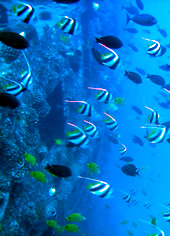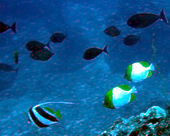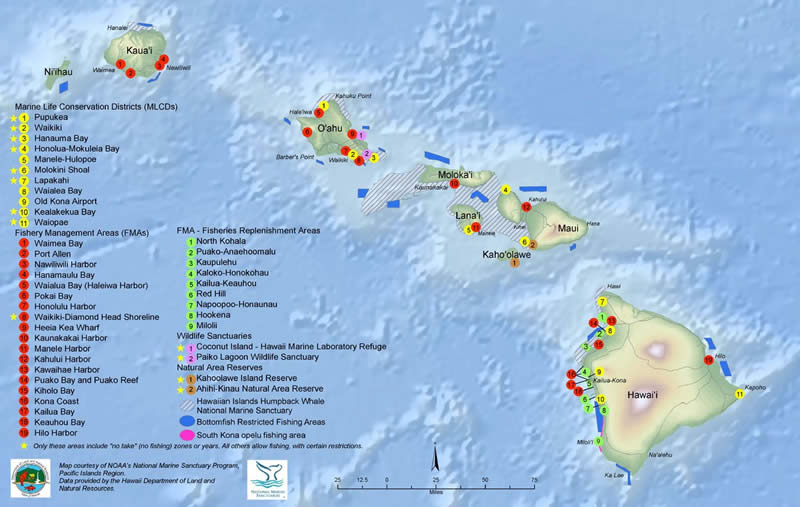Welcome to Hawaii’s Sustainable Aquarium Fishery Scientific Facts
Hawaii’s Aquarium Fishery has been studied more than any other fishery in the world. Both the 2,400 page Environmental Review of the West Hawaii fishery, and the Oahu Environmental Review, based in State fish counts and reports covering nearly 20 years of data, scientifically prove Hawaii’s aquarium fishery is eco-friendly, having low environmental impact. The head of Hawaii Department of Land and Natural Resources (DLNR) – Suzanne Case,stated Hawaii’s Aquarium Fishery is a “Model Fishery”. With many reef fish populations on the rise overall, Hawaii’s Aquarium Fishery is the true definition of “Sustainability.”
Hawaii’s leading scientist speak out in opposition to DLNR Land Boards decision not to approve the environmental review of the West Hawaii Aquarium fishery. This review was based on many of these scientist research and then they were not even questioned or consulted about the board decision. It was like the science did not matter.
Hawaii’s top marine biologists William Walsh Ph.D., Ivor Williams Ph.D., Brian Tissot Ph.D.; Leon Hallacher Ph.D.; Bruce Carlson Ph.D.; Charles Birkeland Ph.D.; Jeremy Claisse Ph.D.; Mark Christie Ph.D.; Richard Pyle Ph.D.; Leighton Taylor Ph.D.; Randy Kosaki Ph.D.; Cynthia Hunter Ph.D.; Brian Bowen Ph.D.; Brian Zgliczynski Ph.D.; Jeff Ebel Ph.D.; Alan Friedlander Ph.D.; Kosta Stamoulis Ph.D.; Delisse Ortiz Ph.D.; Jan Dierking Ph.D.; Rob Toonen Ph.D.; and Jim Beets Ph.D. Thursday, June 25, 2020, all signed the letter condemning the DLNR land board decision not to approve fisheries environmental review. Why? Because the fishery is sustainable.
Most reef fish produce 10,000 to 5 million fry per spawning, and with spawning occurring up to as many as seven times per year, their ability to repopulate is staggering! Moreover, marine biologists have stated that the Hawaii fisheries’ most favorite fish- the indigenous Yellow Tangs- produce one million fry per pair per year! Further, warmer temperatures brought on by global warming, only seem to stimulate spawning. An example of this is the fish population increase of 2014 and 2015. Indeed, the Fish base website, which rate fish species vulnerability rates, indicates low vulnerability for all fish species taken by the proven sustainable aquarium fishery. None of these fishes are at risk of extinction. The Sustainability of the fishery being based on science should not be in question.
According to the state regulatory agency DLNR’s 17 year study of the fishery, fish counts for the major species collected were up by millions. The years of Kona fish count research was headed by DLNR marine biologist, Bill Walsh, Ph.D., who worked with his team of marine biologists to count fish and review years of fish reports and studies. These studies showed that Hawaii’s small aquarium fishery was sustainable, and had a low impact on Hawaii’s oceans. The state has issued aquarium permits for over 60 years. Yet fish count data and catch reports up to 2017 show no major recent fish catch increases or declines in fish. Instead, fish counts were increasing for the 2017 fishery. In the past, DLNR has opposed closure of the fishery basing their decision on years of catch report data and fish counts. Why now with a reduced number of aquarium divers, reduced fish take, and proven sustainability, in the face of an environmental review ruling, has the DLNR changed their minds?
Hawaii Aquarium Trade Under Unconstitutional Attack Despite Sustainable Effective Management of the Fishery – Why?
Last year Hawaii’s world famous and most famous leading marine scientists came out in Support of the fishery. Despite this, the support of Hawaii’s Aquarium Fishery repeatedly finds itself still under attack. Why is it under attack? The answer is user conflict from a small, vocal tourist-based group whose eco-funding drives an emotional debate over the Hawaii fishery. The opposition, snorkel dive charters with a stake in owning the oceans, gain by shutting the fishery down. This opposition group wants all to pay to see Hawaii’s fish from their tours only. This conclusion is evidenced by tourist groups who testified against new fish catch limits as proposed by Hawaii’s aquarium fishermen (enact new laws to protect fish) who were willing to go the extra mile and were working with Hawaii’s DLNR Land Board in 2015! What kind of ecology group testifies against fish protection laws? One that is not really based on ecology or science, but a user group who wishes to be the only ones who profit from Hawaii’s oceans.

Our fishery has proven effective at management. Aquarium fishermen’s livelihoods depend on plentiful fish supply. For many years DLNR successfully managed the fishery; many new laws were implemented to regulate the fishery. FRA (Fish Management Areas) were created in Kona to separate the user groups and allow fish to repopulate. Over 1,600 fish counts were done and fish populations were on the increase with millions more fish on the reefs. The already sustainable aquarium fishery became even more regulated and sustainable when, the Hawaii Tropical Fish Association met with DLNR scientists to create new laws to ensure the sustainability of the Hawaii’s aquarium fishery. These additional laws took the form of the Oahu and Kona aquarium collecting rules packages and went into effect in 2014 and 2015. These new rules created enhanced restrictions on diver’s gear, species restrictions, size limitations, and quantities (bag limits) of fish that could be collected. To further prevent ocean user conflict, numerous areas statewide remain open to tourists but closed to aquarium fishermen. DLNR employees have stated that if they fail to manage the fishery effectively then they have not done their jobs. Clearly the results of the 20 years studied and the incredible fish population increases have shown DLNR has done its job!
How will other fisheries respond to working with governments to introduce laws if they still get shut down anyway? The fishery no longer exists on Maui. It had only a handful of divers 8 years ago, but it was blamed for fish population declines on the island. They claimed that the fishery has unlimited “take,” but there are many laws Hawaii’s laws for the fishery which prove that to be untrue.
The United Nations has deemed that oceans are the common heritage of all men, and that no individual group should lay claim to own it. Current attacks violate the United States Constitution, and the Hawaii State Constitution, both of which state that oceans belong to the public. Governing agencies are there to manage the oceans not to eliminate user groups. To restrict access to or eliminate any user group over another without the science to back-up the decision, particularly one in which many Hawaiians work, is clearly a violation to the State of Hawaii Constitution, and puts the state at legal risk. Aquarium fishermen were told by lawyers that we could legally sue DLNR for removing our permits, but unlike our opposition we have morals and ethics, especially regarding facts and truth.
There are several public and commercial marine aquariums for tourism in Hawaii who rely on the fishery (e.g. Oceanarium, Sea Life Park, Waikiki Aquarium, Waikaloa, and Disney resort), and the potential for increasing the production of the state’s already valuable marine aquaculture business that are also dependent on aquarium fishermen and the laws affecting them. People may soon have to resort to diving or snorkeling to see Hawaii’s fish, which will benefit the main proponents of the fishery closure- a few radical snorkeling and dive shop owners who have led this unsubstantiated, biased attack on Hawaii’s sustainable aquarium fishery. Ignoring the scientific evidence with which to measure their ecological concerns, they are primarily concerned with their bottom line, not ecology, and have sold the majority of legislators, eco-groups, and the public, a bill of goods which will have negative impacts on tourism and our economy.

Hawaii’s beautiful fish seen in aquariums around the world, allow education about sustainable ecosystems to occur, and encourage tourists to come to Hawaii. If tourist-based user conflict groups succeed in closing the fishery, no one will be able to learn about Hawaii’s tropical fish in aquariums. Now that, will be a big loss- to the fishermen, state business, and airlines and even to tourism.
For years, special interest groups- have used the guise of “ecology,” to attack the Hawaii Aquarium Fishery by promoting the fallacy that there is a lack of Hawaii tropical fish and aquarium fishermen have no restrictions. Anti-aquarium fish advocates refuse to listen to science, instead not budging on the stand that the fishery needs to be totally shut down. They use untruths because 20 years of scientific studies conducted by the state’s ocean researchers show fish population increasing, which does not back up their claims. Laws affecting ecological concerns must be based in science, or they will undermine the meaning and importance of real ecological issues.
Hawaii’s small, but important aquarium fishery faces an uncertain future. With corals in Hawaii recovering, we as fishermen are still not letting our guard down. We will continue to work with DLNR to ensure sustainability and fish and ocean health. Many ocean issues in the past have been reported and aquarium fishermen have aided researchers in studying them. We love giving back to the ocean that we love.
We can only hope those who are making very important life changing decisions educate themselves about the issue and make the right decision.
Tina Owens executive director of the LOST FISH Coalition, Member West Hawaii Fisheries Council says:
A great deal of the “sky is falling” news you’ve heard about the reef recently is just plain not true.
Try giving credit to the thousands of volunteer hours given by your neighbors to the West Hawaii Fisheries Council to get the gains you are now free to enjoy. (done with the help of Aquarium Fishermen on the council who agreed to the laws)
Lost Fish Coalition, through the venue of the West Hawaii Fisheries Council, has been working with many stakeholders to get a reasonable settlement to the long-standing problem of the aquarium industry harvest. In almost 16 years, we have accomplished the following management actions:
• We have 55-plus miles of coastline where reef fish cannot be taken. These areas allow the fish to grow large enough to be very successful breeders. These areas — Fish Replenishment Areas — are the nurseries for the reef fish to spread out to the rest of the reefs.
Thanks to these measures, West Hawaii has more fish than most every other widely accessed reef in the state, especially the beautiful ornamentals that give tourists and residents so much delight. If someone says that nothing has been done in West Hawaii, they are either lying, unaware or are being duped by someone else’s lies about the situation. There are a few “outsiders,” by which I mean people who don’t live here, who have decided that West Hawaii doesn’t know what it’s doing. This group, headed by Maui resident Robert Wintner, and Wintner’s frontman Rene Umberger, decided it was going to be the ones to get aquarium collecting banned, to make themselves the “rescuers of the reef.”
Clearly if the goal is to get rid of the industry and management prevents that goal being reached, then discrediting the benefits and successes of management would seem the only way left to go. And so they have taken that path.
They have held community meetings and displayed a lot of false or twisted data, quoting from papers outdated by more than 15 years, and “re-interpreting” data from scientific papers. They have been telling people that “there are no fish left,” which is patently untrue. I once had a woman tell me with great passion and assurance that there are no fish left anywhere in West Hawaii. I asked her why she thought that, and she replied that everyone knew it. I asked if she swam in the ocean. No. Did she dive? No. Did she know anything about the management strategies in place? No. She had, however, just come from an “information session” in which she heard these things from Wintner’s frontman Rene Umberger.
Which brings me back to the wide-screen TV. The TV runs a 90-minute loop of undisturbed, natural activity of fish on the reef. Apparently, the footage was filmed on West Hawaii reefs. The article states: “Wintner praised the videos. ‘It shows what abundance looks like,’ Wintner said.”
At least he got that right.
~ Tina Owens, executive director of the LOST FISH Coalition, Member West Hawaii Fisheries Council and resident of Kailua-Kona.
See for yourself News links:
Videos show tropical fish swarming state’s reefs
CORAL Excerpt: “Biblical” Spawning Event on Hawaiian Reefs


